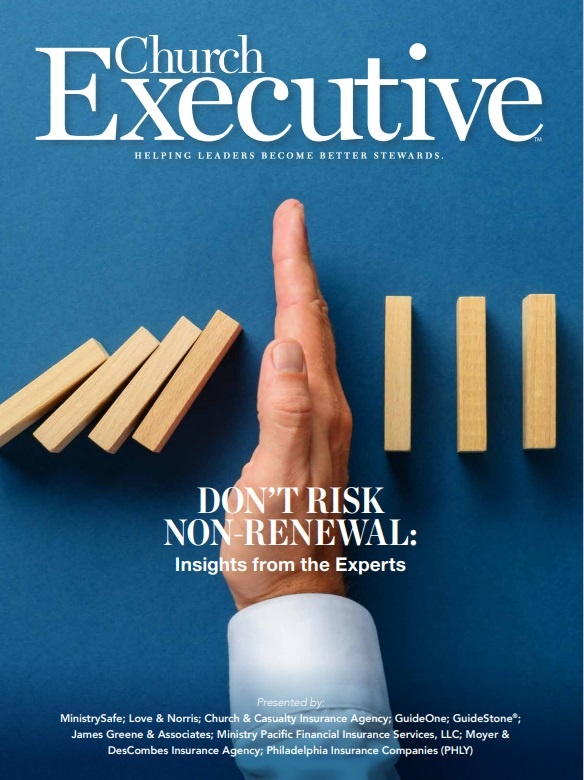
 Now is the time to set your church on a path to safety and insurability — now and into the future
Now is the time to set your church on a path to safety and insurability — now and into the future
By Travis Tjepkema, CIC
In my nearly 30 years in the church insurance marketplace, right now is the most unique time I’ve ever experienced in the industry.
Increased weather-related claims and economic and social inflation have driven US property and casualty market carriers to significant rate increases and increased non-renewal activity.
Churches are not immune from this marketplace, and non-renewals are higher than ever.
Church non-renewals are typically due to one or a combination of the following three reasons:
1) Physical location is in a catastrophe-prone area (fire, wind, flood);
2) Care and condition of the facilities/lack of risk management; or
3) Claims history.
While an insurance non-renewal is not a death sentence, it is, unfortunately, a scarlet letter — and getting replacement coverage with other carriers can often result in premiums that are two to three times higher.

While coverage, premiums and services are still vitally essential insurance considerations, insurability (keeping your church an attractive risk for carriers to insure) has become paramount.
Besides relocating, very little can be done to avoid a non-renewal due to a church’s location in a catastrophe-prone area. If you believe you are in one of them, I encourage you to begin that discussion with your agent months before your policy expires, and well before you potentially receive a non-renewal notice. Alternative insurance options are available for these areas.
Below are 5 key strategies to stay insured and keep your pricing as competitive as possible.
#1: Don’t defer property maintenance
Insurance carriers are increasing physical property inspections, even using drones to examine roofs, and conducting surveys to confirm electrical and plumbing updates. A good rule of thumb is to have your roofing, electrical and plumbing inspected for maintenance, upgrades or replacement every 15 to 20 years. Carriers are looking for proof these areas have been addressed at renewal.
#2: Be proactive with risk management
The bedrocks of church risk management begin with an up-to-date employee handbook and a fully encompassing abuse prevention plan (not just background checks). Security teams must have written safety plans; and if you have church-owned automobiles, you should be vetting your drivers and have an established maintenance plan for all vehicles. Carriers want to see plans and procedures not just created but implemented.
Also, confirm you have adequate lighting around your facilities, as well as security cameras and a plan to address loitering on your grounds after hours. Be proactive in your risk management.
#3: Don’t file multiple small property claims
Carriers typically evaluate your claims history over the last six years. While a previous claim never officially “drops off” your record, the last six years of history are the most important.
There’s a phrase in the industry: “Frequency breeds severity.” It’s not a good look to the insurance carrier if you have multiple property claims, especially of the same type (water damage, for example). Determine what size property loss you can handle internally and raise your deductible to that level.
#4: Respond to risk control recommendations
Carriers will often send a risk control representative to your facilities for inspection. They then provide a written list of recommendations for items such as an updated inspection for your kitchen ventilation hood, clearing out a storage closet or clutter from a hallway, ensuring your gutters and downspouts are free and clear of debris, and so on.
You must respond to these recommendations. Failure to address these items is a red flag for an insurance carrier, and they will look unfavorably at your upcoming renewal.
#5: Partner with the right agency
You want an agency that:
• Specializes in insuring churches and understands your exposures. This agency should also provide access to multiple risk management resources to help lower your exposures (many of which should be free).
• Prioritizes continuity of coverage. When you move from one house to another, you want to ensure everything in the moving truck makes it to your new location. The same holds true when you switch carriers. Check for key coverage items with your new policy, specifically: 1) building limit replacement costs, 2) business income / extra expense, 3) codes and ordinance, and 4) professional liability retro-dates are matching expiring.
• Takes immediate action if you face a non-renewal. You must have confidence in your agency to immediately provide a plan of action and options to consider for replacement policies.
In closing, Do you have someone in charge of executing the strategies above, and does he or she have the backing of the church leadership and/or board? These are good on paper but better in execution.
Travis Tjepkema, CIC is president of Church & Casualty Insurance Agency. [ www.ccia.com ]. Church & Casualty was established in 1983 and presently insures more than 6,000 houses of worship throughout the southwestern United States.


